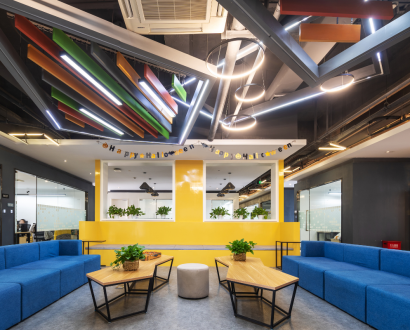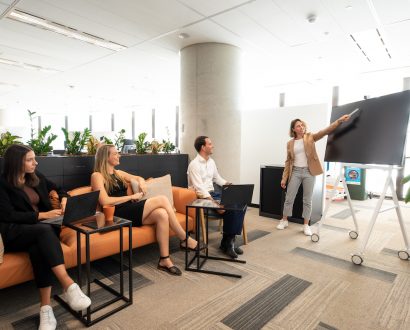How workspace innovations are driving collaboration and agility

Gone are the days of dusty desk cubicles, tapping away in isolation under the harsh glare of strip lighting or clock-watching in a soulless meeting room as the hours tick by. With more and more businesses pursuing an ‘agile’ way of working, workspaces have to follow suit to support this new era of flexible working, with dynamic new layouts that foster creativity and collaboration.
This is even truer now as hybrid working arrangements become the new norm post-pandemic. Workers want to dip in and out of a space that makes their working hours fun and inspiring while supporting their professional objectives.
"The world of work has changed enormously in the last two years, as organisations start to realise the opportunities that are emerging due to hybrid working," Sean Wilcock, Associate Director of architect firm Davenport Campbell, tells The CEO Magazine. "We are coming out of the dark and starting to figure out how we can all work better together."
It’s a change that is perhaps long overdue. Even before the pandemic burst onto the scene, changing the way we work ostensibly forever, companies were wasting vast sums on office space that wasn’t being properly used. As far back as 2017, a study by Philips Lighting estimated that businesses across the globe were squandering up to US$1.5 trillion in wasted office space, financial losses and a carbon footprint that could be reduced through a process of renovation and tech upgrades.
The Agile Refit

The beauty of an agile workspace lies in its offer of choice, control and flexibility. Featuring open-plan workspaces, breakout areas, quiet zones and touchdown areas, they make any style of work possible. Whether you feel like brainstorming, need to have a more private meeting or simply want to get your head down in peace, there is a space for you. By empowering employees in this way, companies are letting them decide how they work best, enhancing productivity and satisfaction – great news for everyone.
"The more adaptive the workplace, the better we can deal with change; like a chameleon changing its colour to adapt to different environments," Wilcock says. "As we adapt to change, the workplace needs to adapt as well. This needs to be achievable in a way that is easy to do and doesn’t cost of lot of money."
"The more adaptive the workplace, the better we can deal with change; like a chameleon changing its colour to adapt to different environments." – Sean Wilcock
These are all factors that inspired the firm’s collaboration with Australian property firm Mirvac to create a new "adaptive workspace", which it unveiled in Sydney earlier this year, with Mirvac’s General Manager of Strategy and Customer Paul Edwards insisting an "urgent change" was needed. With many team members opting to split their time between the office and home, the "human-centric" nature of the office had to be emphasised.
"Since COVID-19, we have seen hybrid and flexible work become the new normal, and Mirvac recognised the need to adapt our workplace design and developments to accommodate these new, emerging styles and typologies of work," he explains.
"The role of the office has never been more vital; it should operate as a space that entices, energises and enables people to do their best. The new era office needs to facilitate a culture of connection, collaboration, business productivity, innovation and learning – all things that are best done in a physical environment."
A Working Space
Since launching the space, Mirvac has encouraged employees and their teams to "hack" the space to suit their specific needs and work styles. "Already we’re seeing vastly different layouts of the space between divisions; for example, Digital completely took over one team zone, moving desks to allow them to collaborate throughout the day and have visibility of each other’s work," Edwards reveals.
In another clever agile move, global property firm JLL incorporated a 15-minute meeting room in its Shanghai office, which opened back in 2019, designed to cater to the fact that the human attention span ranges between 10 and 18 minutes. The collaboration area is designed for huddle-style team catch-ups, with the lighting set up to ensure that meetings don’t drag beyond 15 minutes.
"It is recognising that in most cases, you can’t do everything from home, and that building a culture based upon social connection remains paramount." – Sean Wilcock
It’s all about making the workplace align with a company’s purpose and serve the people who work there to best effect, helping them to interact productively. "Architecturally, we must look for these opportunities around every corner; whether it’s your first impression as you walk in the front door each day or providing spaces that help people do their job the best possible way," Wilcock says.
"It is recognising that in most cases, you can’t do everything from home, and that building a culture based upon social connection remains paramount."
Tech in the Picture
Technology also enables companies to keep an eye on how such spaces are being used, according to Alex Birch, the CEO and Co-Founder of tech firm XYSense. "The only way to measure utilisation accurately and efficiently is through technology-like workplace sensors so that you can build a true picture of the work that’s being done in the office, confirm whether or not the adaptive spaces fit the true needs of employees, and continuously evolve and improve," he explains.
"The only way to measure utilisation accurately and efficiently is through technology-like workplace sensors so that you can build a true picture of the work that’s being done in the office." – Alex Birch
"From our global dataset, we’re seeing each organisation’s workplace usage pattern is quite unique. And there is currently so much uncertainty around what makes a hybrid workplace effective. Our goals are to help maximise the hybrid worker’s experience by reducing workplace friction and help determine the optimal amount of space required for cost effectiveness."
By its very nature, the agile workspace is an ongoing evolution. If companies can effectively cater to the needs and desires of their people while aligning the space with the company’s purpose, then the possibilities are endless.
Agile Workspace Essentials
- Focus on the user – consider team members’ needs when designing the space.
- Simplify your environment – agile spaces should be open, offering flexibility and a sense of connection.
- Offer choice – provide a range of workspaces for different kinds of work.
- Rethink meetings – consider a stand-up meeting space with video capabilities for remote workers.
- Create a vibe – decorate the space in a fun and inspiring way.
- Invite collaboration – give team members the tools to get creative together – whiteboards, pin-up walls and charts.
- Embrace change – agile workspaces should continually evolve as the company’s needs shift.